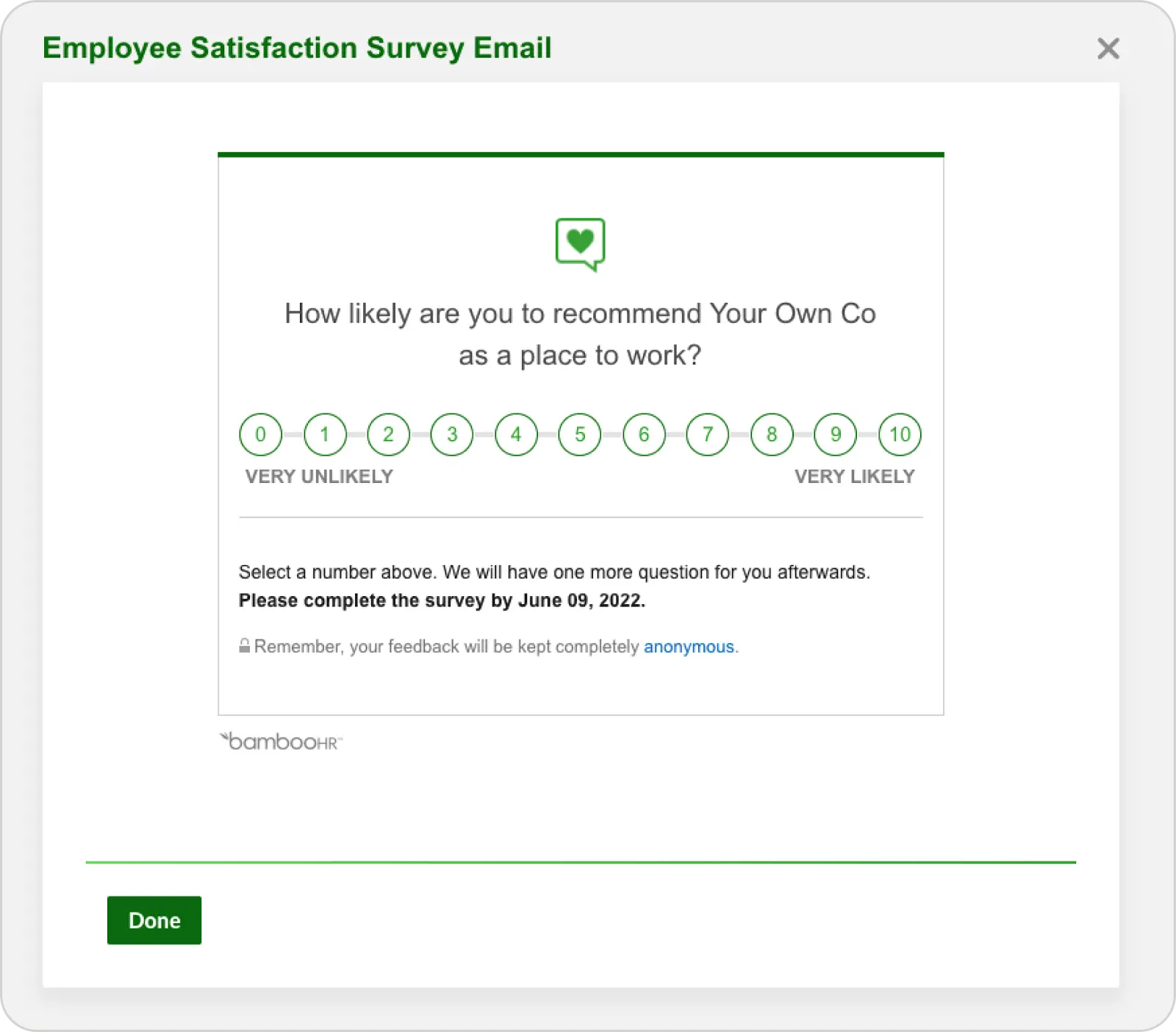Employee engagement is the degree to which workers feel invested in or connected to their work and the organization. Engaged team members are generally more productive and excited about their jobs. Knowing how to measure employee engagement helps you gain insight into what workers think is going well with your company and which areas need improvements.
Key Takeaways
- Employee engagement is an important aspect of a successful business, as it greatly impacts productivity, staff well-being, and turnover.
- Staff surveys, including those that use employee net promoter score (eNPS), are some of the popular ways to measure employee engagement.
- Using multiple methods to track employee engagement will give you a comprehensive view of your workforce’s commitment and motivation levels.
- The data you get by measuring employee engagement allows you to identify areas that need improvement and create strategies to address issues.
There are many ways to help you monitor staff engagement levels. The below list highlights some of the key methods on how to measure employee engagement.
Employee Surveys
Running an employee survey is one of the traditional methods of measuring employee engagement. Depending on the type of survey conducted, you can gather quantitative and qualitative data to help you determine your organization’s level of engagement. Some of the popular options include the following:
This can be sent to employees once or twice in a calendar year. Conducting surveys following this schedule provides you a bit more time to come up with actionable solutions to address problem areas. Annual engagement surveys usually include around 10 or more questions with responses that require you to select the best answer from a scale or range of answer options.
Some sample questions and responses include the following:
Sample Engagement Survey Questions | Sample Responses |
|---|---|
Do you believe that your work plays an important part in the company? | Scale of 1-5, with “Strongly Disagree” to “Strongly Agree” answers |
Do you find work meaningful? | Scale of 1-5, with “Never” to “Always” answers |
Are you proud to work for the company? | Scale of 1-5, with “Not at all” to “Extremely” answers |
You can create an employee survey and distribute these to your workforce yourself, but online solutions, like those on our list of the best employee survey tools, will automate the process. Some HR and payroll systems also offer similar functionalities, so if you use one, check if you have access to survey features to help you gather insights from your workforce.
This is similar to annual or biannual engagement surveys but follows a shorter format and is sent out to employees either monthly or quarterly. The beauty of running pulse surveys is that it allows you to get frequent updates of the workforce’s engagement levels. However, you might miss long-term trends if you continuously focus on issues that come up on a monthly or quarterly basis.
Employee net promoter score (eNPS) surveys are a worker-centric version of the net promoter score survey, which is used to measure customer loyalty. For employees, it asks a single question—the likelihood they will recommend the company that employs them as a good place to work. Similar to the usual engagement surveys, team members are presented with a response scale, but instead of 1 to 5, the answer option goes from 0 (not at all likely) to 10 (extremely likely).
To compute the survey scores, identify how many responses would fall under these categories:
- Promoters: Those who chose scores of nine and 10
- Passives: Those who chose scores of seven or eight
- Detractors: Those who chose scores of zero to six
After sorting the responses, subtract the percentage of Promoters from the percentage of Detractors to get the final eNPS. For example, if 15% of the survey respondents are Detractors, 25% are Passives and 60% are Promoters, your final NPS would be 45 (computed as 60 − 15 = 45).
If calculating this is a bit complicated, consider using an HR system like BambooHR. It provides access to eNPS survey tools in its starter plan, which makes creating online surveys and computing the applicable score easy for users. To learn more, read our BambooHR review.

With BambooHR, you can send eNPS surveys via email. (Source: BambooHR)
While an eNPS survey is simpler to implement, this may not provide a complete picture of your team’s engagement levels. For a comprehensive view, consider using the traditional employee engagement measurement survey.
One-on-One Sessions
Unlike surveys that allow you to gather data from the whole organization or big teams, one-on-one sessions offer a more personalized way to measure employee engagement. You can schedule this as often as you need and want. And because these one-on-one sessions are private, you can engage in a safe conversation with the employee and ask additional questions to get more information about issues that come up.
Part of managing employees is conducting feedback meetings to let team members know how they’re doing at work and ask about their general well-being. You can structure these sessions with talking points that follow or are similar to questions included in employee engagement surveys. This can be scheduled every month or quarter or alongside performance reviews. If you choose the latter and use a performance management system, you can add the worker’s responses to the online performance review form. Depending on the software you have, you can even include those responses as reference notes for follow-up feedback meetings.
With a stay interview, you can schedule a 30-minute one-on-one session with an employee to help you understand what makes the worker stay with your company. In conducting this interview, you should get a mix of highly engaged and disengaged team members. This employee engagement measurement method allows you to get both positive and negative feedback that can affect overall staff engagement, productivity, and talent retention.
You can ask questions requiring employees to choose the best answer on a scale of 1-5, with five as the highest. Or, you can use open-ended questions to get qualitative responses. Here are some stay interview questions.
- What would make your daily work more satisfying?
- What would make you leave for another company?
- What are your thoughts about how employees are recognized?
Exit interviews provide insights into the engagement levels of voluntary leavers, including their reasons for leaving the company. Many employers consider this as one of the vital steps of the employee offboarding process, as it allows them to address issues proactively.
Let’s say the common complaint raised by voluntary leavers, those who resigned on their own and were not terminated, is poor benefits options. You may want to take a look at your benefits package, conduct a market analysis to check competitiveness, and assess whether you have the budget to enhance your benefits in the following calendar year.
Some examples of exit interview questions are as follows:
- What were your reasons for leaving the company?
- What are the challenges you faced while working at this company?
- Do you have suggestions on ways to improve the company?
Focus Group Discussions
A focus group discussion (FGD) is similar to one-on-one sessions, but these are conducted with a small group of employees instead of just one worker. In addition to helping you gather worker sentiment about engagement and other topics, you can use these meetings as brainstorming sessions to collect suggestions on how to address potential issues. FGDs also allow you to observe how other employees react to feedback shared.
While it’s ideal if the participants belong to the same team or department to encourage free-flowing conversations, it can also be done with a mixed group. However, you need to focus on general engagement questions instead of asking about department-related engagement issues.
HR Metrics
One of the ways to measure employee engagement is by looking at HR metrics. These can be good indicators of your workforce’s motivation and engagement levels. Here are some metrics you can use to get a glimpse of staff engagement.
Disengaged employees are more likely to change jobs when they see zero opportunities for growth or have a negative experience at work. With this rate, which shows the percentage of employees who voluntarily left your organization for a specific period, you can get an idea of how high or low your workers’ engagement levels are.
However, simply using this HR metric for measuring employee engagement isn’t ideal. You need to pair it with an exit interview to help you understand which factors contributed to the employee’s decision to leave the company.
Workers who don’t feel motivated with their jobs will most likely report less for work. These unplanned absences can disrupt your day-to-day operations and overall productivity.
If you have high employee absenteeism rates and a majority of the absences lack legitimate reasons, this suggests that you may have some disengaged workers. You may want to conduct one-on-one sessions with concerned employees to gauge their engagement levels and uncover whether they are struggling with personal or work issues. Scheduling regular check-ins with their managers can also help, as well as implementing company policies designed to help workers, such as flexible work and mental health support programs.
Engaged employees are generally more productive at work, so keeping an eye on worker productivity rates helps you spot low engagement levels. If workers constantly fail to meet key performance indicators (KPIs) that they usually have no problems with, then that’s a good indicator of disengagement at work.
There are many productivity factors that you can measure to help show engagement levels. For a list of the common metrics, check out our guide on measuring employee productivity.
Why Tracking Employee Engagement is Important
Employee engagement affects more than just your workers’ motivation and enthusiasm levels at work—it impacts overall business performance and day-to-day operations. Knowing how to measure employee engagement and tracking these diligently will help you spot and understand issues that make workers feel demotivated with their jobs and workplaces. This allows you to show workers that you value their feedback and are receptive to making improvements to enhance overall engagement.
You can also use data collected from employee engagement measurement methods to identify areas that are working well and those that need to be enhanced. This helps to determine which action plans to prioritize based on the qualitative and quantitative feedback you received from workers.
Best Practices for Measuring Employee Engagement
There are many tools and ways to measure employee engagement. While you must determine which methods are ideal for your company, here are a few tips to help you manage the process efficiently.
- Keep engagement questions short to retain employee interest: For traditional surveys, limit the list of questions to around 10 to 20. For one-on-one sessions, you should also take note of the meeting length—it shouldn’t exceed 30 minutes.
- Run anonymous surveys: Some employees are wary of leaving honest feedback if their names appear on the survey. Allowing them to complete surveys without indicating their names may likely entice them to leave comments or share what they think and feel.
- Provide a platform for employee feedback: This can be a simple suggestion box you leave at the workplace or an online version you can add to your company intranet. Don’t forget to remind employees where they can find the suggestion boxes and make sure you check them regularly.
- Use multiple methods: It’s okay to use more than one employee engagement measurement method. You can use eNPS surveys with focus group discussions, HR metrics, and stay or exit interview sessions. This approach will help you get a more holistic view and a better understanding of why employees may or may not feel engaged at work.
Measuring Employee Engagement vs Employee Satisfaction
The terms employee engagement and employee satisfaction are often used interchangeably. However, it doesn’t mean that by measuring employee engagement, you also determine staff satisfaction levels. While both are related, these two have distinct concepts.
Employee satisfaction measures the extent to which employees are happy at work and how certain factors meet their needs and expectations. These can be how they feel about their jobs, their dealings with colleagues and managers, and the pay, benefits, and development opportunities they receive.
On the other hand, while employee engagement measurement methods also consider the same factors, these are more complex, enabling you to gauge how motivated and enthusiastic workers are with their jobs and workplaces. These metrics are often taken as signs of their commitment to stay with a company.
Frequently Asked Questions (FAQs)
Measuring engagement will help you know how your employees are doing at work, allowing you to discover areas or issues that may need to be enhanced. Addressing these issues not only improves engagement but also helps to boost business productivity, operations, and staff retention.
It depends on your business goals. Measuring employee engagement on a monthly or quarterly basis is ideal if you want to get frequent feedback and identify potential issues before they become bigger problems. Meanwhile, annual assessments are great for gauging the effectiveness of long-term HR initiatives designed to boost engagement.
The strongest indicators of high employee engagement levels in an organization include low absenteeism and turnover or attrition rates, increased work productivity and performance, and higher staff retention numbers.
Yes, but I wouldn’t recommend this to small businesses as it can be a costly option. You may be charged anywhere from $100 to $250 per hour for HR consulting services. However, if you partnered with a professional employer organization (PEO) service to manage your HR and payroll administration tasks, check if they offer employee survey tools and services that include managing the entire process and providing recommended action plans.


